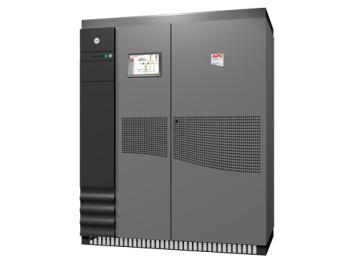MGE UPS Systems GALAXY 6000 User Manual

MGETM GalaxyTM 6000:
Specification guide
__________________________________
Parallel UPS, 250 to 3000 kVA*
* Power rating for an N+1 configuration.

MGETM GalaxyTM 6000 : Specification guide
Parallel UPS, three-phase, 250 to 3000 kVA*
* Power rating for an N+1 redundant configuration
Contents
1 - UPS definition .......................................................................................................................................... |
D-3 |
|
1.1 |
- Purpose ......................................................................................................................................... |
D-3 |
1.2 |
- Brief description............................................................................................................................. |
D-3 |
2 - Operating principle.................................................................................................................................. |
D-4 |
|
2.1 |
- Normal operation ........................................................................................................................... |
D-4 |
2.2 |
- Operation on battery power........................................................................................................... |
D-4 |
2.3 |
- Battery recharge ............................................................................................................................ |
D-4 |
2.4 |
- Parallel operation with redundancy ............................................................................................... |
D-4 |
2.4 |
- Transfer to bypass AC source....................................................................................................... |
D-4 |
2.5 |
- UPS maintenance.......................................................................................................................... |
D-4 |
2.6 |
- Battery maintenance...................................................................................................................... |
D-5 |
2.7 |
- Cold start (AC power absent) ........................................................................................................ |
D-5 |
3 - Sizing and general characteristics ........................................................................................................ |
D-5 |
|
3.1 |
- Technology .................................................................................................................................... |
D-5 |
3.2 |
- Rating ............................................................................................................................................ |
D-5 |
3.3 |
- Battery backup time....................................................................................................................... |
D-5 |
3.4 |
- Types of loads accepted................................................................................................................ |
D-5 |
3.5 |
- Limitation of harmonics upstream of the UPS............................................................................... |
D-6 |
3.6 |
- Efficiency ....................................................................................................................................... |
D-6 |
3.7 |
- Noise level ..................................................................................................................................... |
D-6 |
4 - AC sources............................................................................................................................................... |
D-6 |
|
4.1 |
- Normal AC source ......................................................................................................................... |
D-6 |
4.2 |
- Bypass AC source ......................................................................................................................... |
D-6 |
5 - Electrical characteristics ........................................................................................................................ |
D-6 |
|
5.1 |
- Rectifier and charger ..................................................................................................................... |
D-6 |
5.2 |
- Batteries......................................................................................................................................... |
D-7 |
5.3 |
- Inverter........................................................................................................................................... |
D-7 |
5.4 |
- Static bypass ................................................................................................................................. |
D-8 |
5.5 |
- Discrimination and short circuit capacity ....................................................................................... |
D-8 |
5.6 |
- System earthing arrangement ....................................................................................................... |
D-9 |
6 - Mechanical characteristics..................................................................................................................... |
D-9 |
|
6.1 |
- Mechanical structure ..................................................................................................................... |
D-9 |
6.2 |
- Modular design .............................................................................................................................. |
D-9 |
6.3 |
- Dimensions .................................................................................................................................... |
D-9 |
6.4 |
- Connections................................................................................................................................... |
D-9 |
6.5 |
- Ventilation ...................................................................................................................................... |
D-9 |
6.6 |
- Safety............................................................................................................................................. |
D-9 |
7 - Environment conditions ......................................................................................................................... |
D-10 |
|
7.1 |
- UPS (not including battery)............................................................................................................ |
D-10 |
8 - Protection ................................................................................................................................................. |
D-10 |
|
8.1 |
- UPS ............................................................................................................................................... |
D-10 |
8.2 |
- Rectifier/chargers .......................................................................................................................... |
D-10 |
8.3 |
- Inverters......................................................................................................................................... |
D-10 |
8.4 |
- Batteries......................................................................................................................................... |
D-10 |
9 - Battery management ............................................................................................................................... |
D-11 |
|
9.1 |
– Self-test......................................................................................................................................... |
D-11 |
9.2 |
- Measurement of actual backup time ............................................................................................. |
D-11 |
9.3 |
- Digital battery management........................................................................................................... |
D-11 |
9.4 |
- Block by block monitoring.............................................................................................................. |
D-11 |
10 - User interface and communication ..................................................................................................... |
D-12 |
|
10.1 - User interface .............................................................................................................................. |
D-12 |
|
10.2 - Communication............................................................................................................................ |
D-13 |
|
11 - Maintainability........................................................................................................................................ |
D-13 |
|
11.1 - Local and remote diagnostics and monitoring - E. Services ....................................................... |
D-13 |
|
12 - Standards and tests ............................................................................................................................. |
D-14 |
|
12.1 - Standards .................................................................................................................................... |
D-14 |
|
12.2 - Certification of conformity............................................................................................................ |
D-14 |
|
13 - Test procedures and quality system .................................................................................................. |
D-14 |
|
13.1 - Test procedures........................................................................................................................... |
D-14 |
|
13.2 - Quality system ............................................................................................................................. |
D-14 |
|
14 - Services .................................................................................................................................................. |
D-15 |
|
14.1 - Maintenance ................................................................................................................................ |
D-15 |
|
14.2 - Technical competency................................................................................................................. |
D-15 |
|
14.3 - Functional components ............................................................................................................... |
D-15 |
|
14.4 - System start-up ........................................................................................................................... |
D-15 |
|
14.5 - Replacement parts ...................................................................................................................... |
D-15 |
|
14.6 - Recycling and renovation ............................................................................................................ |
D-15 |
|
15 - Warranty ................................................................................................................................................. |
D-15 |
|
16 - Installation services .............................................................................................................................. |
D-15 |
|
17 - Electrical diagram.................................................................................................................................. |
D-16 |
|
Appendix. Comparison table ....................................................................................................................... |
D-18 |
|
APC By Schneider Electric |
Edition - 03/2009 |
Spec. E - 2 |

MGETM GalaxyTM 6000 : Specification guide
Parallel UPS, three-phase, 250 to 3000 kVA*
* Power rating for an N+1 redundant configuration
1 - UPS definition
1.1 - Purpose
The purpose of this specification is to define the design, manufacture and testing characteristics required in view of supplying, putting into operation and maintaining an Uninterruptible Power Supply (referred to as a UPS in the rest of this document).
The UPS shall be designed to supply dependable electric power to:
For information purposes |
MTBF in |
Non availability |
|
hours |
|
|
|
|
Single-UPS unit with static bypass |
475000 |
2.1x10-5 |
|
|
|
Active modular redundancy n+1 with centralized |
|
|
bypass |
|
|
2 UPS units |
3.11x106 |
3.22x10-6 |
3 UPS units |
2.42x106 |
4.14x10-6 |
4 UPS units |
1.97 x106 |
5.07 x10-6 |
5 UPS units |
1.67x106 |
6 x10-6 |
6 UPS units |
1.44x106 |
6.95 x10-6 |
1.2 - Brief description
The UPS system shall be made up of …[ 2 / 3 / 4 / 5 / 6 ]…identical parallel-connected UPS units with the same power rating, operating in double-conversion mode (also called on-line mode) in accordance with the VFI category described in standard IEC 62040-2.
Each UPS unit shall have a unit rating of …[ 250 / 300 / 400 / 450 500 / 600 / 800 ]… kVA, made up of the following components, described in this specification:
ωrectifier;
ωbattery charger;
ωinverter;
ωbattery;
ωa battery-management system.
In addition, the UPS shall be equipped with:
…………………………………………………………………………………………………………………………..
() for parallel connection of two single UPS units, with redundancy)
ωstatic bypass (via a static switch) on each unit;
ωmanual maintenance bypass on each unit;
ωuser and communications interface on each unit.
…………………………………………………………………………………………………………………………..
() for parallel connection with an external maintenance-bypass cabinet, up to four units)
ωstatic bypass (via a static switch) on each unit;
ωcommon, external, maintenance bypass for all units, installed in a cabinet;
ωuser and communications interface on each unit.
…………………………………………………………………………………………………………………………..
() for parallel connection with a centralized-bypass cabinet, up to six units)
ωa centralized bypass shall be made up of the following components:
-static bypass (via a static switch);
-manual maintenance bypass.
The centralized bypass shall be sized to support the entire load. Consequently, its power rating shall be …[ 250 / 500 / 800 / 1200 / 2000 …] kVA.
ω a user and communications interface for the entire UPS system.
The UPS system shall also comprise any and all other devices required for safe operation and maintenance, including circuit breakers, switches, etc.
The UPS system shall ensure continuity of electric power to the load within the specified tolerances, without interruption upon failure or deterioration of the normal AC source (utility power) for a maximum protection time determined by the capacity of the backup batteries installed.
APC By Schneider Electric |
Edition - 03/2009 |
Spec. E - 3 |

MGETM GalaxyTM 6000 : Specification guide
Parallel UPS, three-phase, 250 to 3000 kVA*
* Power rating for an N+1 redundant configuration
2 - Operating principle
The double-conversion UPS (also called on-line) shall operate as defined below.
2.1 - Normal operation
(normal AC source available)
The rectifier supplies the inverter with DC current while the charger simultaneously float charges the battery. The load is continuously supplied with dependable electrical power by the inverter.
() for parallel connection with a centralized bypass cabinet, up to six units)
A current-loop system shall ensure automatic distribution of the total load between the various parallel-connected units.
2.2 - Operation on battery power
(normal AC source not available or outside tolerances)
Upon failure or excessive deterioration of the normal AC source, the inverter shall continue to supply the load from battery power without interruption or disturbance, within the limits imposed by the specified battery backup time.
2.3 - Battery recharge
(normal AC source restored)
When the normal AC source is restored, the rectifier shall again power the inverter, without interruption or disturbance to the load, while the charger automatically recharges the battery.
2.4 - Parallel operation with redundancy
………………………………………………………………………………………………………………………………….
() without redundancy)
The system shall not be redundant. The [ 2 / 3 / 4 ] UPS units must operate in parallel to supply the load. Shutdown of one unit shall result in transfer to
…[ the various static bypasses, connected to the same bypass AC source ] …[ the centralized bypass ]
…………………………………………………………………………………………………………………………………..
() with redundancy)
The units shall operate in parallel and redundantly, with the load shared equally between the units. Redundancy shall be of the "n+1" (or n+2) type, i.e. "1" (or 2) units shall be redundant in the total of n units. If a major fault occurs on a unit, it shall automatically disconnect.
If the remaining unit(s) are sufficient to supply the load, it/they shall remain in operation.
If the total available power is insufficient, the load shall be automatically transferred, without interruption, to the bypass AC source, if it is within tolerances.
…………………………………………………………………………………………………………………………………..
2.5 - Transfer to bypass AC source
In the event of an overload exceeding system capabilities or UPS shutdown, the static bypass switch shall instantaneously transfer the load to the bypass AC source without interruption, on the condition that bypass power is available and within tolerances.
…………………………………………………………………………………………………………………………………..
() for parallel connection with an external maintenance-bypass cabinet, up to four units)
During transfer, the system shall simultaneously switch the static switches.
…………………………………………………………………………………………………………………………………..
() for parallel connection with a centralized-bypass cabinet, up to six units)
Transfer shall be carried out by the common static bypass in the centralized-bypass cabinet, with simultaneous orders to the UPS units.
………………………………………………………………………………………………………………………………….
Transfer of the load back to the UPS-unit output, synchronised with the bypass AC source, shall be automatic or manual. During transfer, the load shall not suffer an outage or disturbance in the supply of power.
On request, the UPS system may automatically transfer the load with a micro-interruption if a major fault occurs on the UPS system and if synchronisation with the bypass source has not been established.
APC By Schneider Electric |
Edition - 03/2009 |
Spec. E - 4 |

MGETM GalaxyTM 6000 : Specification guide
Parallel UPS, three-phase, 250 to 3000 kVA*
* Power rating for an N+1 redundant configuration
2.6 - UPS maintenance
For maintenance purposes, all electronic components shall be accessible from the front of the UPS. In addition, a manually operated mechanical bypass system shall be:
…………………………………………………………………………………………………………………………………..
-Built into each UPS unit () for a two-UPS system with active redundancy)
…………………………………………………………………………………………………………………………………..
-Installed separately in the external maintenance bypass cabinet () with external maintenance-bypass cabinet)
…………………………………………………………………………………………………………………………………..
-Installed separately in the centralized bypass () with centralized-bypass cabinet).
This system shall be designed to isolate the UPS while continuing to supply power to the load from the bypass AC source. The UPS shall also include a device making it possible to isolate the rectifiers and the chargers from the normal AC source.
2.7 - Battery maintenance
For safe maintenance on the battery, the system shall include a circuit breaker to isolate the battery of each parallel-connected UPS unit from the rectifier, the corresponding charger and the inverter. When the battery is isolated from the system, the UPS shall continue to supply the load without interruption or disturbance, except in the event of a normal AC source outage.
2.8 - Cold start (normal AC source absent)
The battery of each unit shall be capable of ensuring UPS start-up even if normal AC power is not available and continuing operation within the specified back-up time (start on battery power shall be possible on the condition that the system was already started with AC power present).
3 - Sizing and general characteristics
3.1 - Technology
Each unit in the UPS system shall be based on IGBT technology with built-in thermal monitoring and a high freefrequency chopping mode to dynamically optimise efficiency and power quality.
3.2 - Rating
The UPS system shall be sized to continuously supply a load of kVA, at a power factor (pf) of 0.8.
It shall be made up of ...[2 / 3 / 4 / 5 / 6]... UPS units, each with an identical rating of ...[ 250 / 300 / 400 / 500 / 600]... kVA.
The total installed power rating shall thus be kVA. ...[Consequently, 1 (or 2) unit(s) may be redundant.]
3.3 - Battery backup time
The battery backup time in the event of a normal AC source outage shall be _______ minutes, for a load power factor of 0.8.
Battery service life shall be equal to at least …[ 5 / 10 ]…years. It shall be selected and sized correspondingly, for a load power factor of 0.8.
3.4 - Types of loads accepted
The UPS shall accept high crest factors (3:1) without derating to ensure correct operation with computer loads. The total harmonic voltage distortion at UPS output (THDU downstream) shall respect the following limits:
ωTHDU downstream ph/ph and ph/N ≤ 4% for linear loads;
ωTHDU downstream ph/ph and ph/N ≤ 4 % for non-linear loads.
APC By Schneider Electric |
Edition - 03/2009 |
Spec. E - 5 |

MGETM GalaxyTM 6000 : Specification guide
Parallel UPS, three-phase, 250 to 3000 kVA*
* Power rating for an N+1 redundant configuration
3.5 - Limitation of harmonics upstream of the UPS
The UPS system shall not draw a level of harmonic currents that could disturb the upstream AC system, i.e. it shall comply with the stipulations of guide IEC 61000-3-4.
To that end, it shall be possible to equip each rectifier/charger input with a filter of the type …[compensated LC / non-compensated LC / with contactor / double-bridge / phase shifting]...
If necessary, it shall be possible to use an electronic active filtering system to obtain, at the normal AC input, the following levels, constant from 50% to 100% load:
ωtotal harmonic current distortion (THDI) upstream of the rectifier/charger not exceeding 4%;
ωinput power factor (pf) greater than 0.94.
3.6 - Efficiency
Overall efficiency shall be greater than or equal to:
ω95% at full rated load (In);
ω93% at half rated load (In/2).
3.7 - Noise level
The noise level for each unit, measured as per standard ISO 3746, shall be less than:
.........................................................................................................................................................................
ω69 dBA () for 250 and 300 kVA units).
ω72 dBA () for 400, 450, 500 and 600 kVA units).
.........................................................................................................................................................................
4 - AC sources
The UPS shall be designed to receive power from the sources listed below.
4.1 - Normal AC source
(rectifier input)
The normal AC source supplying the UPS shall, under normal operating conditions, have the following characteristics:
ω rated voltage: 380 - 400 or 415 volts rms at full rated load Pn; ω voltage: volts, ± 15%;
ω number of phases: 3 + N + earth; ω frequency: Hz ± 10%.
4.2 - Bypass AC source
(static-bypass input, if separate from rectifier input)
The bypass power supplying the UPS in the event of an inverter shutdown (maintenance, failure) or an overload (short-circuit, heavy inrush currents, etc.) shall have the following characteristics:
ω voltage: / volts, ± 10%;
ω number of phases: 3 + N + earth; (a non-distributed neutral is possible); ω frequency: Hz ± 5% (adjustable up to ± 2 Hz).
Outside these tolerances, it shall be possible to supply the load, but in downgraded mode.
5 - Electrical characteristics
5.1 - Rectifier and charger
5.1.1 - Supply
The rectifier and charger module shall be supplied via the normal AC input (see § 4. AC sources) and shall have the characteristics presented below.
5.1.2 - Inrush current
A device shall be provided to limit inrush currents.
When AC power fails and during genset start, the rectifier shall limit the power drawn to 70% of its rating for ten seconds. The remaining 30% shall be supplied by the battery.
5.1.3 - Battery-current limiting
For long battery life, an electronic device shall automatically limit the charging current to the maximum value
APC By Schneider Electric |
Edition - 03/2009 |
Spec. E - 6 |
